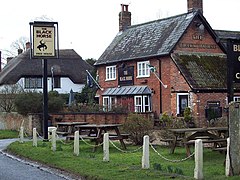Great Durnford
| Durnford | |
|---|---|
 The Black Horse, Great Durnford, 2007 |
|
| Durnford shown within Wiltshire | |
| Population | 368 (in 2011) |
| OS grid reference | SU135380 |
| Civil parish |
|
| Unitary authority | |
| Ceremonial county | |
| Region | |
| Country | England |
| Sovereign state | United Kingdom |
| Post town | Salisbury |
| Postcode district | SP4 |
| Dialling code | 01722 |
| Police | Wiltshire |
| Fire | Dorset and Wiltshire |
| Ambulance | South Western |
| EU Parliament | South West England |
| UK Parliament | |
Durnford is a civil parish in Wiltshire, England, between Salisbury and Amesbury. It lies in the Woodford Valley and is bounded to the west by the Salisbury Avon and to the east by the A345 Salisbury-Amesbury road. The parish church and Little Durnford Manor are Grade I listed.
The main settlement is Great Durnford, 2.5 miles (4.0 km) southwest of Amesbury. To the south, on the bank of the Avon, are the small settlements of Netton, Salterton and Little Durnford.
Evidence of prehistoric activity in the area includes two bowl barrows (Neolithic or Bronze Age) on high ground south of Great Durnford village, and Ogbury camp (Bronze Age or Iron Age), a hilltop enclosure on the summit of a ridge close to the village. Durnford is within the Stonehenge, Avebury and Associated Sites World Heritage Site, and Great Durnford lies some 2.7 miles (4.3 km) southeast of the Stonehenge monument.
The Domesday Book of 1086 recorded 71 households at Durnford and a small settlement at Netton. The ancient parish of Durnford included Normanton, north of Great Durnford on the west bank. This part was transferred to Wilsford cum Lake parish in 1885.
Little Durnford Manor was built in the late 17th century and remodelled c. 1720-1740. The house is Grade I listed and has a dining room described by Pevsner as "a splendid mid C18 room with a proud chimmneypiece and wall panels of tapestry framed in plaster". There was probably a medieval village at Little Durnford, beside the river, but this had disappeared by the 18th century after parkland was created for the manor house.
The Manor House at Great Durnford was built in brick in the 18th century, then acquired in 1904 by George Tryon, who altered and extended the house in 1912-13, and became Baron Tryon of Durnford in 1940. Dreda Tryon, wife of George's son Charles, ran a boarding preparatory school for girls at the house from 1942 until 1992.
...
Wikipedia

